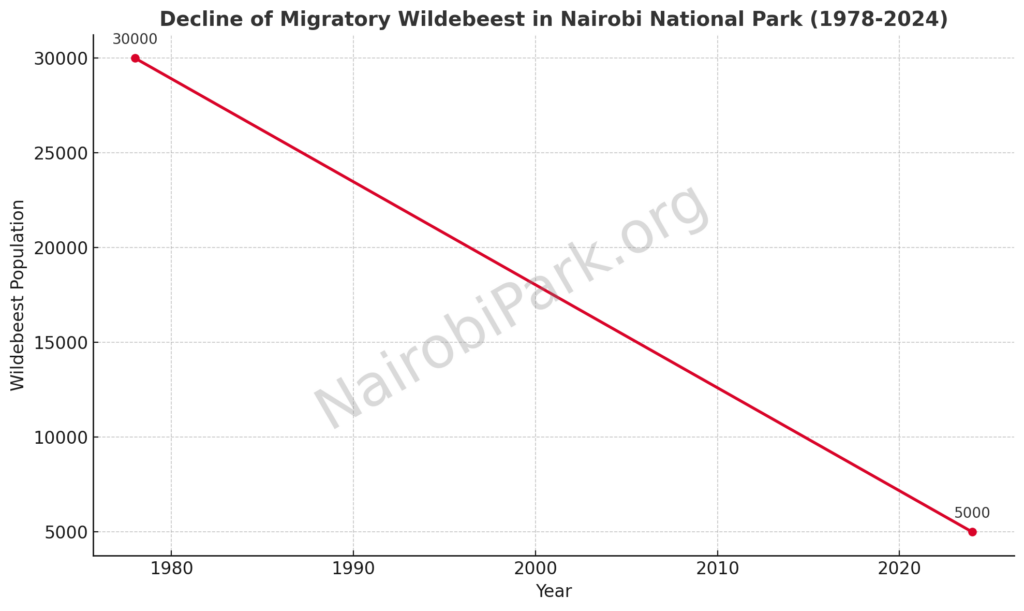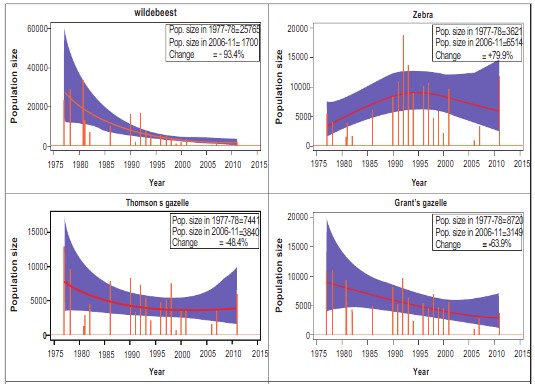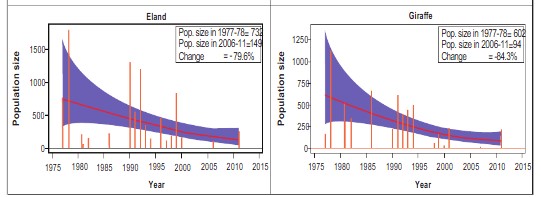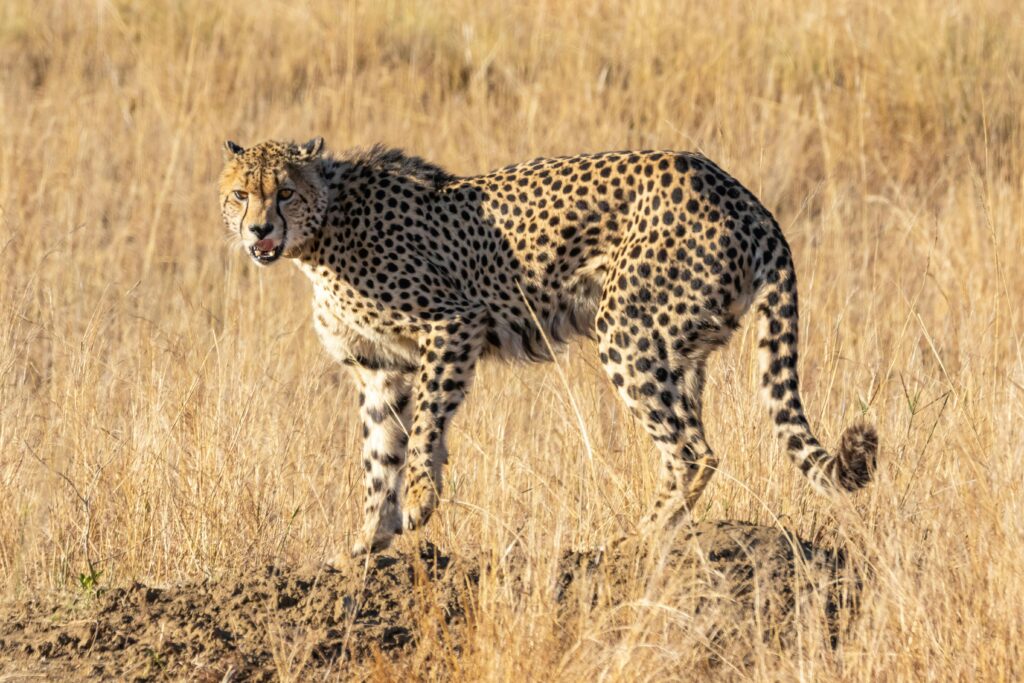Nairobi National Park (NNP) is a unique wildlife sanctuary nestled within Kenya’s bustling capital. Despite its proximity to an urban environment, the park is home to several endangered and critically endangered species, making it an important stronghold for biodiversity conservation in Kenya. The park plays a pivotal role in wildlife conservation, hosting species that face significant threats due to habitat loss, human-wildlife conflict, and poaching.
1. Black Rhinoceros (Diceros bicornis)

The black rhinoceros is one of the most critically endangered species in Nairobi National Park, with about 50 individuals recorded in recent reports.
This population forms part of Kenya’s national black rhino sanctuary program, with the park offering a secure, fenced environment to protect them from poaching. NNP’s black rhinos benefit from intensive monitoring, anti-poaching patrols, and secure habitats, which have helped stabilize their population despite external threats.
2. Cheetah (Acinonyx jubatus)
Cheetahs are listed as vulnerable but face increasing risks in Nairobi National Park due to habitat fragmentation and competition with other large predators like lions. With fewer than five individuals commonly sighted, cheetahs in NNP rely on the open grasslands where they hunt smaller antelope species. The challenge for their conservation lies in the park’s limited space, which restricts their natural roaming behavior.
3. African Lion (Panthera leo)
While lions are classified as vulnerable globally, populations in Kenya, including those in NNP, face localized threats. There are around 7 lions in Nairobi National Park, and their survival is threatened by human-wildlife conflict, particularly when lions occasionally leave the park and venture into nearby residential areas, leading to fatal encounters. The park’s lions are crucial for genetic diversity in Kenya’s lion population.
4. White Rhinoceros (Ceratotherium simum)
The white rhinoceros, though classified as near-threatened globally, enjoys relatively stable protection in Nairobi National Park, with about 19 individuals reported. Unlike the more aggressive black rhino, white rhinos are grazers and prefer open savanna habitats. NNP provides such an environment, along with rigorous protection measures to guard against poaching.
5. Leopard (Panthera pardus)
Leopards are elusive and rarely seen in Nairobi National Park, with only 3 individuals estimated to reside within the park’s boundaries. Classified as vulnerable, leopards face threats from habitat fragmentation and conflict with human populations. The dense bush areas in NNP offer them cover for ambushing prey, but their secretive nature makes population monitoring challenging.
6. Bohor Reedbuck (Redunca redunca)
Though not globally endangered, the bohor reedbuck population in Nairobi National Park is relatively small, with around 22 individuals reported. This decline is attributed to habitat degradation and competition with larger herbivores. Their preferred habitats of riverine grasslands are increasingly pressured by urban development.
7. Eland (Taurotragus oryx)
Elands, the largest antelope species, are considered near-threatened in Kenya, with a declining population trend in Nairobi National Park—only 40 individuals have been recorded. Elands are sensitive to human disturbances, and the growing urban sprawl around the park limits their range and access to traditional migratory routes.
8. Waterbuck (Kobus ellipsiprymnus)
With just 2 individuals recorded, the waterbuck population in Nairobi National Park is critically low. This sharp decline is due to habitat loss and competition with other herbivores. The park’s shrinking wetlands, a preferred habitat for waterbucks, exacerbate their vulnerability.
9. Bushbuck (Tragelaphus scriptus) and Suni (Neotragus moschatus)
Both species are rarely seen in Nairobi National Park, with bushbucks having a single recorded individual and sunis about two. Habitat loss and predation are the primary threats. These species prefer dense undergrowth, which is increasingly rare due to human encroachment.
10. Bateleur (Terathopius ecaudatus) and Secretary Bird (Sagittarius serpentarius)
These raptors, classified as endangered and vulnerable respectively, are threatened by habitat loss and declining prey availability. They rely on the open grasslands of NNP, where they hunt for small mammals and reptiles. Conservation efforts focus on habitat preservation and mitigating human disturbances.
Conservation Efforts in Nairobi National Park
Nairobi National Park’s strategic importance lies in its role as a refuge for endangered species within an urban setting. Key conservation measures include:
- Anti-Poaching Patrols: The Kenya Wildlife Service (KWS) maintains stringent anti-poaching units to safeguard rhinos, lions, and other vulnerable species.
- Habitat Management: Efforts to control invasive plant species and maintain grassland ecosystems are critical for supporting herbivores and their predators.
- Wildlife Corridors: The Nairobi Wildlife Corridor facilitates animal movement between the park and neighboring conservancies, reducing human-wildlife conflicts.
NNP serves as a living laboratory for conservation, demonstrating that wildlife can coexist with urban development through dedicated management and community involvement.
Key Threats to Wildlife at Nairobi National Park
1. Habitat Fragmentation and Urbanization
The rapid expansion of Nairobi city has led to encroachment into wildlife dispersal areas. Historically, Nairobi National Park had open migratory corridors to the southern Athi-Kapiti plains. However, urban sprawl, real estate development, and land subdivision have drastically reduced these critical pathways. Studies show that migratory routes for species like wildebeest, which numbered over 30,000 in the 1960s, have been completely blocked, leading to the collapse of seasonal migrations. This isolation limits genetic diversity and restricts access to essential grazing grounds, exacerbating population declines.
2. Infrastructure Development
Major infrastructural projects such as the Standard Gauge Railway (SGR), roads, and fences cutting through wildlife corridors have further disrupted animal movement. The SGR, for example, passes through parts of the park, causing both physical barriers and behavioral changes in wildlife. Species like giraffes and zebras are particularly affected as they are reluctant to cross underpasses or navigate around human-made structures.
3. Human-Wildlife Conflict
With animals increasingly forced to roam outside the park’s boundaries in search of food and water—especially during the dry season—human-wildlife conflicts have escalated. Predators like lions occasionally stray into nearby residential areas, causing alarm and sometimes leading to retaliatory killings. This not only reduces predator populations but also tarnishes local perceptions of conservation efforts.
4. Poaching and Illegal Wildlife Trade
Although NNP benefits from its proximity to government security agencies, poaching remains a significant threat, particularly for rhinos. The park has both black and white rhinoceros populations, species targeted for their horns. Despite increased anti-poaching patrols, poaching incidents have been reported, particularly before intensified security measures were introduced in the late 2010s.
5. Climate Change and Droughts
Climate variability has resulted in erratic rainfall patterns, leading to prolonged droughts that affect water availability and forage.
This disproportionately impacts herbivores like wildebeest, hartebeest, and gazelles, whose populations have declined by approximately 70% over the past decades due to reduced food resources.

Drought also exacerbates competition between wildlife and livestock, especially when herders illegally graze their cattle within the park.


6. Invasive Plant Species
The spread of invasive plant species, such as the Lantana camara, has altered the park’s natural vegetation structure. These plants outcompete native grasses, reducing food availability for grazers and affecting the entire food chain. This shift impacts not just herbivores but also predators that rely on healthy prey populations.

7. Pollution and Waste Management Issues
Runoff from Nairobi’s industrial and residential areas introduces pollutants into the park’s ecosystem, affecting water quality in rivers and wetlands. Additionally, improper waste management near the park’s borders leads to the accumulation of plastic waste, which can be ingested by animals or cause entanglement.
8. Disease Outbreaks
Human encroachment increases the risk of zoonotic diseases transferring between domestic animals and wildlife. For instance, bovine tuberculosis and foot-and-mouth disease outbreaks have been recorded among buffalo and antelope populations, often traced back to interactions with livestock.
Read more of the threats to Nairobi N.P. as captures in the Management Plan.
Wildlife Population Trends
- Wildebeest: Once exceeding 30,000 in the 1960s, the migratory population has collapsed due to blocked migratory corridors.
- Gazelle, Hartebeest, Waterbuck, and Warthog: Declines of 70% have been documented, attributed to habitat loss and competition with livestock.
- Rhinos: Black and white rhino populations are under constant threat from poaching despite stringent protection measures.
Conservation Strategies Needed
- Securing Wildlife Corridors: Initiatives to reclaim and protect dispersal areas in the Athi-Kapiti plains are vital.
- Strengthening Anti-Poaching Units: Enhanced surveillance, community involvement, and technological tools like drones can bolster security.
- Community Engagement: Encouraging local communities to participate in conservation through eco-tourism benefits can reduce human-wildlife conflict.
- Habitat Restoration: Managing invasive species and replanting native vegetation will help restore ecological balance.
- Climate Adaptation Strategies: Building artificial water holes and managing grazing pressure can mitigate drought impacts.

